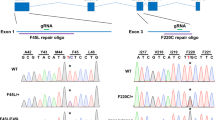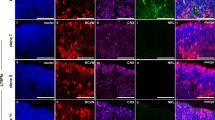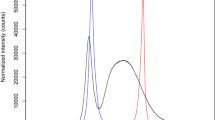Abstract
Crx, an Otx-like homeobox gene, is expressed specifically in the photoreceptors of the retina and the pinealocytes of the pineal gland1,2. Crx has been proposed to have a role in the regulation of photoreceptor-specific genes in the eye and of pineal-specific genes in the pineal gland. Mutations in human CRX are associated with the retinal diseases, cone-rod dystrophy-2 (adCRD2; refs 3, 4, 5), retinitis pigmentosa5 (RP) and Leber congenital amaurosis5,6 (LCA), which all lead to loss of vision. We generated mice carrying a targeted disruption of Crx. Crx–/– mice do not elaborate photoreceptor outer segments and lacked rod and cone activity as assayed by electroretinogram (ERG). Expression of several photoreceptor- and pineal-specific genes was reduced in Crx mutants. Circadian entrainment was also affected in Crx–/– mice.
This is a preview of subscription content, access via your institution
Access options
Subscribe to this journal
Receive 12 print issues and online access
$209.00 per year
only $17.42 per issue
Buy this article
- Purchase on Springer Link
- Instant access to full article PDF
Prices may be subject to local taxes which are calculated during checkout






Similar content being viewed by others
References
Furukawa, T., Morrow, E.M. & Cepko, C.L. Crx, a novel otx-like homeobox gene, shows photoreceptor-specific expression and regulates photoreceptor differentiation. Cell 91, 531–541 (1997).
Chen, S. et al. Crx, a novel Otx-like paired-homeodomain protein, binds to and transactivates photoreceptor cell-specific genes. Neuron 19, 1017–1030 (1997).
Freund, C.L. et al. Cone-rod dystrophy due to mutations in a novel photoreceptor-specific homeobox gene (CRX) essential for maintenance of the photoreceptor. Cell 91, 543–553 ( 1997).
Swain, P.K. et al. Mutations in the cone-rod homeobox gene are associated with the cone-rod dystrophy photoreceptor degeneration. Neuron 19, 1329–1336 (1997).
Sohocki, M.M. et al. A range of clinical phenotypes associated with mutations in CRX, a photoreceptor transcription-factor gene. Am. J. Hum. Genet. 63, 1307–1315 (1998).
Freund, C.L. et al. De novo mutations in the CRX homeobox gene associated with Leber congenital amaurosis. Nature Genet. 18, 311–312 (1998).
Li, X. et al. A pineal regulatory element (PIRE) mediates transactivation by the pineal/retina-specific transcription factor CRX. Proc. Natl Acad. Sci. USA 95, 1876–1881 (1998).
Blackshaw, S. & Snyder, S.H. Developmental expression pattern of phototransduction components in mammalian pineal implies a light-sensing function. J. Neurosci. 17, 8074– 8082 (1997).
Humphries, M.H. et al. Retinopathy induced in mice by targeted disruption of the rhodopsin gene. Nature Genet. 15, 216– 219 (1997).
Sanyal, S. & Jansen, H.G. Absence of receptor outer segments in the retina of rds mutant mice. Neurosci Lett. 21 , 23–26 (1981).
Reuter, J.H. & Sanyal, S. Development and degeneration of retina in rds mutant mice: the electroretinogram. Neurosci. Lett. 48, 231–237 (1984).
Liou, G.I. et al. Retina-specific expression from the IRBP promoter in transgenic mice is conferred by 212 bp of the 5-'flanking region. Biochem. Biophys. Res. Commun. 181, 159–165 (1991).
Boatright, J.H. et al. A major cis activator of the IRBP gene contains CRX-binding and Ret-1/PCE-I elements. Mol. Vis. 3, 15 (1997).
Bovolenta, P., Mallamaci, A., Briata, P., Corte, G. & Boncinelli, E. Implication of OTX2 in pigment epithelium determination and neural retina differentiation. J. Neurosci. 17, 4243–4252 (1997).
Foxman, S.G., Heckenlively, J.R., Bateman, J.B. & Wirtschafter, J.D. Classification of congenital and early onset retinitis pigmentosa. Arch. Ophthalmol. 103, 1502–1506 (1985).
Foster, R.G. Shedding light on the biological clock. Neuron 20, 829–832 (1998).
Provencio, I., Jiang, G., De Grip, W.J., Hayes, W.P. & Rollag, M.D. Melanopsin: an opsin in melanophores, brain, and eye. Proc. Natl Acad. Sci. USA 95, 340– 345 (1998).
Sun, H., Gilbert, D.J., Copeland, N.G., Jenkins, N.A. & Nathans, J. Peropsin, a novel visual pigment-like protein located in the apical microvilli of the retinal pigment epithelium. Proc. Natl Acad. Sci. USA 94, 9893– 9898 (1997).
Soni, B.G., Philp, A.R., Foster, R.G. & Knox, B.E. Novel retinal photoreceptors. Nature 394, 27–28 (1998).
Lucas, R.J., Freedman, M.S., Munoz, M., Garcia-Fernandez, J.M. & Foster, R.G. Regulation of the mammalian pineal by non-rod, non-cone, ocular photoreceptors. Science 284, 505–507 (1999).
Freedman, M.S. et al. Regulation of mammalian circadian behavior by non-rod, non-cone, ocular photoreceptors. Science 284, 502– 504 (1999).
Deng, C., Wynshaw-Boris, A., Zhou, F., Kuo, A. & Leder, P. Fibroblast growth factor receptor 3 is a negative regulator of bone growth. Cell 84, 911–921 (1996).
Li, T. et al. Effect of vitamin A supplementation on rhodopsin mutants threonine-17→methionine and proline-347→serine in transgenic mice and in cell cultures. Proc. Natl Acad. Sci. USA 95, 11933– 11938 (1998).
Grosse, J. & Davis, F.C. Melatonin entrains the restored circadian activity rhuthms of syrian hamsters bearing fetal suprachiasmatic nucleus grafts. J. Neurosci. 18, 8032– 8037 (1998).
Goldberg, A.F. & Molday, R.S. Defective subunit assembly underlies a digenic form of retinitis pigmentosa linked to mutations in peripherin/rds and rom-1. Proc. Natl Acad. Sci. USA 93, 13726–13730 (1996).
Sun, H. & Nathans, J. Stargardt's ABCR is localized to the disc membrane of retinal rod outer segments. Nature Genet. 17, 15–16 (1997).
Morrow, E.M., Furukawa, T., Lee, J.E. & Cepko, C.L. NeuroD regulates cell fate determination in the developing neural retina. Development 126, 23–36 (1999).
Acknowledgements
We thank P. Leder and C. Doherty for helping us generate mutant mice; E. Raviola and S. Ito for advice on light and electron microscopy of retinal sections; J. Nathans and T. Shinohara for cDNAs encoding mouse cone opsin (blue, green/red) and rod arrestin, respectively; and S. Fields-Berry, J. Zitz, M. Samson and H. Regan for technical assistance. This work was supported by the Howard Hughes Medical Institute.
Author information
Authors and Affiliations
Corresponding authors
Rights and permissions
About this article
Cite this article
Furukawa, T., Morrow, E., Li, T. et al. Retinopathy and attenuated circadian entrainment in Crx-deficient mice. Nat Genet 23, 466–470 (1999). https://doi.org/10.1038/70591
Received:
Accepted:
Issue Date:
DOI: https://doi.org/10.1038/70591
This article is cited by
-
CRX haploinsufficiency compromises photoreceptor precursor translocation and differentiation in human retinal organoids
Stem Cell Research & Therapy (2023)
-
Rho enhancers play unexpectedly minor roles in Rhodopsin transcription and rod cell integrity
Scientific Reports (2023)
-
Interaction of human CRX and NRL in live HEK293T cells measured using fluorescence resonance energy transfer (FRET)
Scientific Reports (2022)
-
Retinoblastoma tumor cell proliferation is negatively associated with an immune gene expression signature and increased immune cells
Laboratory Investigation (2021)
-
The effects of seasons and weather on sleep patterns measured through longitudinal multimodal sensing
npj Digital Medicine (2021)



